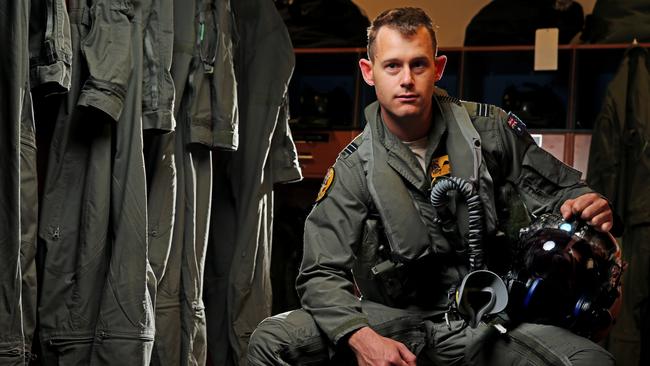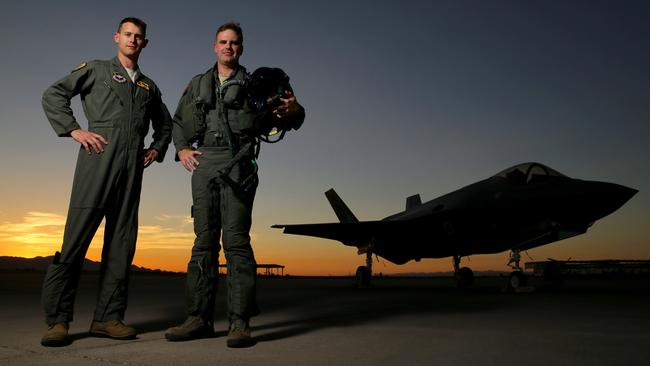Our Aussie Top Guns’ F-35 flight to the future
WEARING $550,000 “Iron Man” helmets, these Aussie pilots are learning to fly the world’s most advanced fighter jets, theF-35s, which are headed to our shores.
National
Don't miss out on the headlines from National. Followed categories will be added to My News.
SQUADRON leader Darren Clare strides toward the flight line in the shimmer of the Arizona desert runway at Luke Air Force Base and as much to himself as to those around him, he muses aloud.
“We’re getting there,” he says with a broad smile as half a dozen F-35 fighters peel out of their bays with a roar as he himself makes for his aircraft, emblazoned with the distinctive RAAF kangaroo roundel.
Just exactly where we are “getting” has been a question the Australia public and Federal Government has rightly been asking for years about the oft-maligned, budget blown next generation F-35 aircraft.
It’s been almost a decade since Australia ordered its first F-35 and at about $120 million each and 72 on order so far, it’s the biggest acquisition of its kind in Australian military history but is yet to see service in Australia.
But for Clare and his team of Aussie “Top Gun” flyers, the getting “there” is both metaphorical and physical.

“We have to pinch ourselves because we are here seeing this every day, line after line of F-35s and from an Australian point of view in Australia it’s still a paper aeroplane in a way because we have only seen it at an air show,” the fighter boss set to lead the squadron to its new home in Australia told the Sunday Mail.
“Because it hasn’t been in Australia people don’t have an appreciation … that’s a big thing for me, it will be great to get the aircraft back and say ‘here it is, it’s here, it’s real and the stuff you are worried about, it can do it and we have the people that can do it and fix it’.
“It is Fifth Generation and it is changing the way we do things.”
And that change is already happening but will go into mach speed when the first of the aircraft make the long-haul hop from Arizona to their new base in Williamtown 30km north of Newcastle this December, via stops in Hawaii, Guam and Queensland.
The Sunday Mail was granted rare exclusive access into the US Air Force’s 61st Squadron based at the sensitive high-security Luke AFB where 40 RAAF pilots, engineers and other service men and women are quietly schooling in the F-35 to lead the aircraft’s much anticipated 2019 introduction into service.
The USAF squad, known as the Top Dogs, is effectively the Top Gun program and such has been the Aussie pilots’ success in graduating from their courses, they are themselves now being seconded to train young American pilots to fly the aircraft before Australia’s training program begins.

The F-35A Lightning II will take Australia’s air combat capability well beyond anything the F/A-18 variants have been able to achieve.
In fact it will take capabilities beyond what any other nation currently has with unparalleled stealth features and a sophisticated suite of technology including almost nine million lines of software code, earning it the moniker “the flying computer”.
Six external infra-red cameras outside the aircraft pull in and stitch the images and information together to feed in real time into the pilot’s $550,000 helmet and on to the visor to virtually allow them to see through the airframe.
Such is the intricacy of the helmet, each one is laser-scanned and moulded personally for its pilot’s head so a shell and mask fits within 1mm. This means most of the flyers have to keep having haircuts almost every fortnight for optimum use. It’s Marvel’s Tony Stark (aka Iron Man) meets Tron but the future is now.
Detractors have pointed to a litany of US Government reports flagging issues with the aircraft including flying limitations but for the team of Australian Defence Force personnel learning to fly, arm, code and fix the aeroplane, the criticisms are misguided.
It’s the first time in 30 years, since the F-111 bomber, that Australia has bought into an aircraft that is still being built, developed, tested, ordered and delivered all at the same time.
“It’s very easy to point out things in the program done poorly and focus on the weaknesses but at the end of the day what’s out there? The answer is F-35,” Squadron Leader Chris Myles said.
“The new kids coming through learning to fly, they’ll cope with it. We jokingly call them the Xbox generation and I think that they will surprise us, be able to cope with things that will amaze us.

“Humans are evolving in this area. This generation … you only have to watch a two or three-year old on an iPhone and just be astounded as they manipulate the touch screens and these are the sort of people who are coming through to fly the F-35.”
Despite the super advanced technology, it’s still apparently easy to fly according to Wing Commander “Junior” (who cannot be identified for security reasons) who first flew an aircraft near his home in Gawler, South Australia, when he was 14 years old and is to be Australia’s first appointed F-35 combat instructor commanding officer.
“A famous fighter pilot said ‘do the ordinary things extraordinarily well’ and what that means is focus on the basics,” the 39-year-old said. “It’s very easy to get swept up on the complexities of the aircraft and tactics but it will be the simple things that will get you unstuck, you doing something that puts the aeroplane in a position to hit the ground.”
Several nations have bought into the F-35 program including the UK, Italy, Netherlands, Canada, Norway and Denmark and controversially, given its political climate and burgeoning alliance with Russia, Turkey.
Israel has also bought the aircraft and has already tested it out in a real-world combat situation with bombing sorties in Syria and another undetected stealth mission over Iran’s capital Tehran and Beirut in Lebanon.
WGCDR Junior said the benefit of the F-35 was Australia had bought into a design that would see up to 5000 aircraft worldwide in use, with a pool of nations contributing to wealth and knowledge.

WGCDR Clare, one of Australia’s most experienced pilots, a combat veteran and the man hand-picked to fly the first aircraft to Australia and be made the Commander of Number 3 combat squadron, said it was a critical acquisition for Australia.
“From an Australia point of view we are a maritime nation, surrounded by sea and we need to protect our approaches and that’s one of the highest priorities set by the government,” he said.
“The growth path for the aircraft will be well and truly beyond any aircraft flying now and while there are some detractors and stuff in the media suggesting this aircraft lacks certain stuff, yes it does but we’re fixing it and we understand what those issues are and can mitigate that in the near term as these get fixed.”
As he took to his aircraft Squadron Leader Chris Baker sums up the feeling among his colleagues.
“This will be great for our country. I just think the way the world is progressing with this fifth gen mindset and the network-connected everything, this is the right platform for us for sure, 100 per cent, there is nothing else out there that’s feasible for us to procure.”

It takes about four months to teach already experienced pilots to fly the F-35 and another three months for them to complete an instructors’ course. There’s another eight months if you are coming in from a basic pilot level. Baker said some of his young students see the F-35 as a very expensive game.
“I know what’s important and you can frame that for a student and highlight to them ‘hey what you are doing right now may feel like a computer game but in six months from now you could actually be doing this for real in a contested environment’.”
Originally published as Our Aussie Top Guns’ F-35 flight to the future
